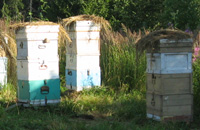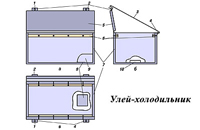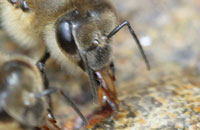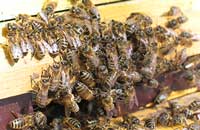![]() Азия — самая крупная часть света. На ее территории обитают девять видов и 44 подвида медоносных пчел (Apis mellifera). От других представителей семейства медоносные пчелы в первую очередь отличаются тем, что производят и хранят большое количество меда, строят многолетние колониальные гнезда из воска.
Азия — самая крупная часть света. На ее территории обитают девять видов и 44 подвида медоносных пчел (Apis mellifera). От других представителей семейства медоносные пчелы в первую очередь отличаются тем, что производят и хранят большое количество меда, строят многолетние колониальные гнезда из воска.
В подрод Micrapis входят наиболее примитивные представители рода Apis. Их семьи относительно небольшие — 4–5 тыс. особей, рабочие пчелы мелкие — длиной всего 7–8 мм. Этот подрод включает два вида: черную индийскую карликовую пчелу (Apis andreniformis F. Smith) и красную индийскую карликовую пчелу (Apis florea Fabricius) [5, 7]. Оба вида широко распространены по всей тропической и субтропической Азии, хорошо приспособлены к жаркому и сухому климату.
У черной карликовой пчелы окраска темная, на лапках черные полосы. Хоботок — около 2,8 мм, кубитальный индекс — 6,37%. Эти пчелы обитают в сильно затененных местах, густых лесах с недостатком солнечного света. Гнездо строят в зарослях бамбука, бананов, густых кустарниках на высоте от 1 до 15 м (в среднем 2,5 м) от земли. Сот один (7–9 см). Как правило, черные карликовые пчелы ведут себя более агрессивно, чем красные карликовые, и начинают нападать на нарушителей на расстоянии 3–4 м от гнезда.
Породы Apis mellifera mellifera, сложившиеся под влиянием климата (от тропиков до Крайнего Севера) и медоносной флоры, сильно различаются между собой. Многие авторы отмечают, что они не похожи друг на друга ни по внешнему виду, ни по характеру, ни по строению и развитию отдельных органов.
МУСТАФА ХАСАН ХУСЕЙН
Университет г. Асьют, Египет
С.Н.НЕПЕЙВОДА, Л.М.КОЛБИНА
ФГБНУ «Удмуртский НИИСХ», г. Ижевск
Аннотация. Дана краткая характеристика видов и подвидов медоносных пчел, обитающих в Азии.
Ключевые слова: Apis, виды, подвиды, пчелы, морфометрия.
ЛИТЕРАТУРА
1. Arias M.C., Sheppard S.W. Corrigendum to Phylogenetic relationships of honey bees (Hymenoptera: Apinae: Apini) inferred from nuclear and mitochondrial DNA sequence data // Mol. Phylogenet. Evol. — 2005. — 3.7
2. Engel M.S. The taxonomy of recent and fossil honey bees (Hymenoptera: Apidae: Apis) // Journal of Hymenoptera Research. — 1999. — 8.
3. Guzman L.I. et al. A new species of Varroa (Acari: Varroidae) associated with Apis koschevnikovi (Hymenoptera: Apidae) in Borneo // Int. J. Acarol. — 1997. — 22.
4. Lo N., Gloag R.S., Anderson D.L., Oldroyd B.P. A molecular phylogeny of the genus Apis suggests that the Giant Honey Bee of the Philippines, A. breviligula Maa and the Plains Honey Bee of southern India, A. indica Fabricius, are valid species // Systematic entomology. — 2010. — 35.
5. Rinderer T.E. et al. Comparative nest architecture of the dwarf honey bees // J. Apic Res. — 1996. — 35.
6. Rinderer T. E., Stelzer J. A., Oldroyd B. P., Tingek S. Levels of polyandry and intercolonial genetic relationships in Apis koschevnikovi // Journal of Apicultural Research. — 1998. — 37.
7. Wu Y.R., Kuang B. Two species of small honeybee — a study of the genus Micrapis // Bee World. — 1987. — 68.
Honeybees, living in Asia
MUSTAFA HASSAN HUSSEIN, S.N.NEPEYVODA, L.M.KOLBINA
Asia - the largest part of the world. Its territory is home to nine species and 44 subspecies of honey bees (Apis mellifera). On the other members of the family honeybees primarily distinguished by the fact that they produce and store large amounts of honey, build long-term colonial nests out of wax.
The subgenus Micrapis are the most primitive members of the genus Apis. Their families are relatively small - 4-5 thousand. Individuals working bees small - only 7-8 mm long. This subgenus includes two types: black dwarf Indian bee (Apis andreniformis F. Smith) and Indian red dwarf bee (Apis florea Fabricius) [5, 7]. Both species are widely distributed throughout the tropical and subtropical Asia, are well adapted to the hot and dry climate.
In a black dwarf bee coloring dark, black stripes on the legs. Proboscis - about 2.8 mm, cubital index - 6.37%. These bees are found in heavily shaded areas, dense forests with a lack of sunlight. The nest is built in a thicket of bamboo, bananas, thick bushes at a height from 1 to 15 m (Average 2.5 m) from the ground. One hundred (7-9 cm). As a rule, the black dwarf bees are more aggressive than red dwarf, and start to attack intruders at a distance of 3-4 meters from the nest.
Species Apis mellifera mellifera, formed under the influence of climate (from the tropics to the far north) and the honey flora differ greatly. Many authors have noted that they do not resemble each other any appearance nor the nature, nor in the structure and development of individual organs.
Annotation. A brief description of species and subspecies of honeybees living in Asia.
Keywords: Apis, species, subspecies, bees, morphometry.

Медонос, заслуживающий внимания…
апр 14, 2015
Помесные пчелы — надолго или навсегда?…
апр 5, 2017
Изменение кислотности меда при хранении…
июнь 25, 2014
Обратимся к прошлому
март 22, 2018
Методы борьбы с болезнями пчел в Чешской…
июнь 11, 2017
Универсальный улей
авг 8, 2023
Разведение пчел при нерегулярном посещен…
нояб 10, 2021
Пчелы в холодильнике
фев 21, 2019
Замена маток перед зимовкой…
сен 3, 2015
Радиация и пчелы
авг 13, 2014
Мед в комплексной терапии нарушений желч…
июль 8, 2015
Как я поймал летящий рой…
дек 7, 2015
Как лучше использовать рои…
март 18, 2014
Мед при производстве БАД, обогащенных эк…
нояб 10, 2022
Кормушка из бутылок
фев 20, 2018












 Адрес редакции журнала "Пчеловодство":
Адрес редакции журнала "Пчеловодство":



